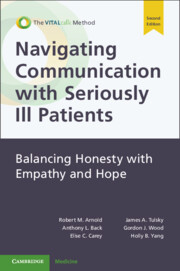Book contents
- Navigating Communication with Seriously Ill Patients
- Navigating Communication with Seriously Ill Patients
- Copyright page
- Dedication
- Reviews
- Contents
- Preface
- Acknowledgments
- 1 Taking Your Skills to the Next Level
- 2 Foundational Communication Skills
- 3 Talking about Serious News
- 4 Discussing Prognosis
- 5 Planning for the Future: Discussing What’s Important, Well Before a Crisis
- 6 Discussing Treatment Decisions
- 7 Between the Big Events
- 8 Goals of Care in Late-Stage Disease
- 9 Conducting a Family Conference
- 10 Dealing with Conflicts between Clinicians and Patients
- 11 Working Through Conflicts with Colleagues
- 12 When You’re Really Stuck
- 13 Talking about Dying
- 14 Cultivating Your Skills
- Index
- References
12 - When You’re Really Stuck
Tracking the Talk … and Adjusting
Published online by Cambridge University Press: 05 April 2024
- Navigating Communication with Seriously Ill Patients
- Navigating Communication with Seriously Ill Patients
- Copyright page
- Dedication
- Reviews
- Contents
- Preface
- Acknowledgments
- 1 Taking Your Skills to the Next Level
- 2 Foundational Communication Skills
- 3 Talking about Serious News
- 4 Discussing Prognosis
- 5 Planning for the Future: Discussing What’s Important, Well Before a Crisis
- 6 Discussing Treatment Decisions
- 7 Between the Big Events
- 8 Goals of Care in Late-Stage Disease
- 9 Conducting a Family Conference
- 10 Dealing with Conflicts between Clinicians and Patients
- 11 Working Through Conflicts with Colleagues
- 12 When You’re Really Stuck
- 13 Talking about Dying
- 14 Cultivating Your Skills
- Index
- References
Summary
Some situations are particularly challenging. These include high-stakes, high-emotion conversations, like when patients talk about miracles or when they request hastened death. In the case of miracles, it is because they understand how bad things are that miracles are invoked. In the case of requests for hastened death, the request is brought on by suffering or fear of suffering. In both cases, the first thing is to do is take a breath and then explore, rather than react from a place of emotion. Another challenge is when responding to emotion isn’t enough. This can occur when a patient really does want information, when patients are coping through intellectualizing, when the emotion is too overwhelming, or when the level of emotion (and sometimes physical agitation) is elevated to the point of feeling or being unsafe. Each of these requires a tailored response like giving information, nonconfrontation, or containment before being able to move forward. Finally, in situations when our own emotions become elevated, it is important to allow ourselves to feel while being mindful we remain of service to the patient, and that we get support from trusted team members and colleagues.
- Type
- Chapter
- Information
- Navigating Communication with Seriously Ill PatientsBalancing Honesty with Empathy and Hope, pp. 185 - 195Publisher: Cambridge University PressPrint publication year: 2024



